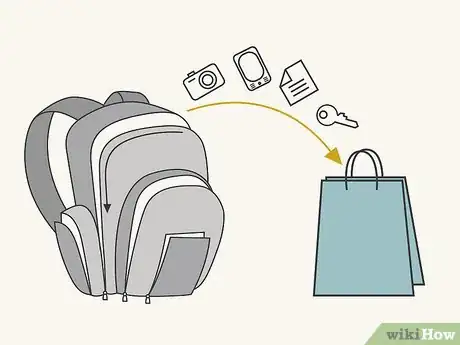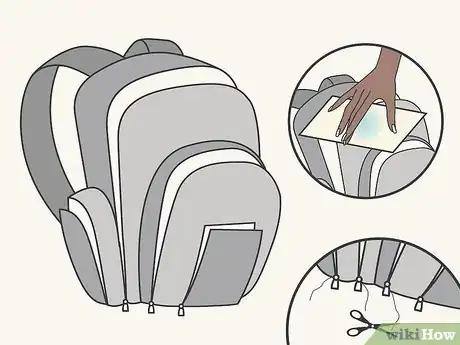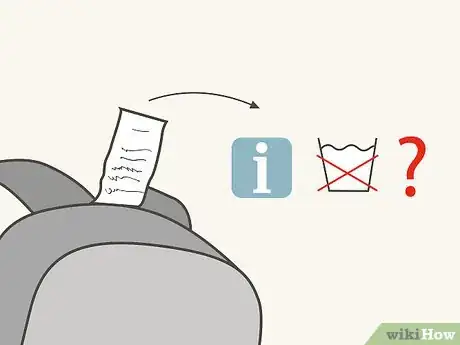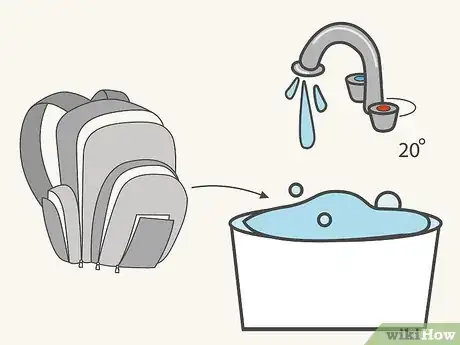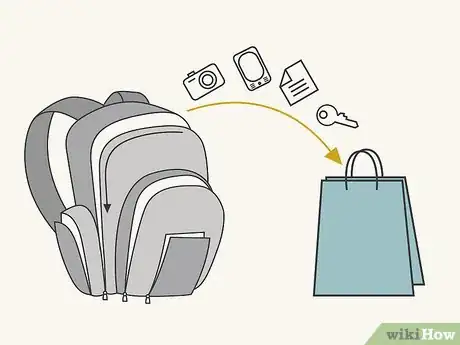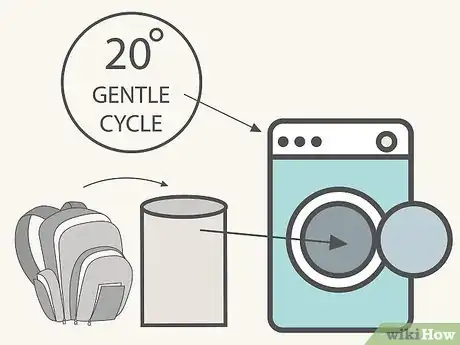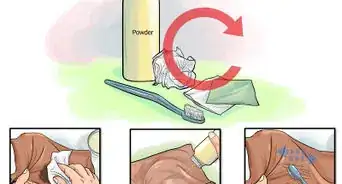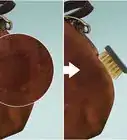wikiHow is a “wiki,” similar to Wikipedia, which means that many of our articles are co-written by multiple authors. To create this article, 28 people, some anonymous, worked to edit and improve it over time.
This article has been viewed 1,058,806 times.
Learn more...
Backpacks are essential for kids, students, and travelers carrying homework and supplies on the go. Over time, food, moisture, and everyday wear and tear can make a backpack filthy and smelly. Luckily, most backpacks are built to endure everyday wear and tear, and they aren't that difficult to clean. Most backpacks can be washed in a regular washing machine using detergent, but others need to be hand-washed depending on the material they are made from. With some light cleaning products and a little bit of elbow grease, you can keep your bag clean, and hopefully extend its lifespan.
Steps
Hand Washing Your Backpack
-
1Empty your backpack. You don't want to wash any items in your backpack that could be damaged by water. Turn your backpack inside out and use a small vacuum to clean the hard to reach interior corners of your backpack that might have small particles of dirt and garbage.[1] Once you are finished emptying your backpack, leave the pockets unzipped.
- Set all of your belongings from inside the backpack in a plastic bag, so you can put it all back in after you clean your bag. That way, you won't lose anything important.
- If you notice that any of your personal items are dirty, clean them now while you are washing your backpack. You don't want to put dirty items back into a clean bag.
-
2Prep your backpack for washing. Use your hands to brush off loose, exterior dirt and dust. Then use a damp rag to lightly wipe down the outside of your bag. This gets off the big, surface dirt, and will help keep your cleaning water as clean as possible.[2]
- If you pack has some kind of frame, make sure to remove it before trying to wash the bag.
- Take off any detachable pockets and straps from the main body of the backpack, and clean them separately. This will ensure that each portion of the bag gets a thorough cleaning.
- Cut away any loose threads or fibers close to the zipping areas.[3] This ensures that along with your clean backpack, you will have a backpack free of snagged and stuck zippers.
Advertisement -
3Check the backpack care label. Always follow the care instructions for the backpack (if it has any) to ensure that you are washing your bag in a way that won’t damage it. Care labels are usually located inside the backpack along a side seam, most likely in the main zipper compartment. The care labels for backpacks usually have recommended information on washing and drying the bag, to ensure its sustainability.
- Certain chemicals and cleaning practices can damage the backpack (its ability to resist water, for example) so it’s best to follow the guidelines that come with the bag.
- If the fabric doesn't have a label for care and washing, test a small area of the fabric to see how it reacts to the cleaning agents you want to use.
-
4Pre treat any stains. Use any pre treatment stain remover of your choice to target dirty spots, but avoid bleach. Use a soft brush (an old toothbrush) to scrub away stain residue, and let the treatment sit for up to 30 minutes. Most of the stain should come off when you actually wash the bag.
- If you don’t have any staining pre treatment, you can use your brush dipped in a 50:50 solution of liquid detergent and water.
-
5Fill a large sink or bathtub with lukewarm water. You can also do this in a laundry basin or laundry sink. Make sure you have plenty of room to really wash out all the pockets and sections of the backpack.
- Avoid hot water, because hot water can cause colors in the backpack to bleed.
- If your care label indicates not to fully submerge the backpack, try wetting and cleaning parts of it with a soaked rag.
-
6Add a gentle detergent to the water. The detergent you use has to be a gentle cleanser that is free of dyes, fragrances, and chemicals. This is because harsh chemicals could damage your backpack’s fabric material (by diminishing the efficacy of the layers of waterproofing on the bag fabric), and the fragrances and dyes could irritate your skin.[4]
-
7Scrub your backpack with a soft brush or rag. You can either fully submerge your backpack in the water, or use the water to dip your scrub brush or cleaning rag in. A brush will help clean areas that are particularly dirty, and a rag is suited better for general cleaning of the bag.
- A toothbrush can be used for getting tough stains out of the backpack material, and getting into hard to reach areas of the bag.
- If your bag is made of a delicate material, like mesh, you might want to use a sponge instead of a brush to prevent damaging the fabric.
-
8Rinse your backpack thoroughly. Rinse out any soap or detergent with lukewarm water to avoid getting a soapy residue on your backpack fabric.
- Wring out the bag to the best of your abilities. You can try laying the bag on a large body towel, and rolling the towel with the bag inside, until it looks like a tube. This helps with absorbing large amounts of water.
- Watch out specifically for zippers, straps, and foam areas when wringing out your bag so you don't damage them.
-
9Dry your backpack. Allow the bag to dry naturally rather than in a drying machine. If possible, let the backpack hang upside down, with the pockets unzipped while it dries.
- You can also try drying the backpack outside in the sun. This will help de-odorize your bag.
- Before the next use or storing the backpack away, be sure that it is completely dry. Leaving it wet when in use or in storage can increase the chances of mold growth on the bag.
Machine Washing Your Backpack
-
1Empty your backpack. Clear your backpack of any items that could be damaged by water while washing your backpack. To help clear out small debris and crumbs in the bottom of the backpack, try turning the backpack inside out and use a handheld vacuum to clear hard to reach nooks and crannies.[5] Leave the backpack's pockets unzipped and open once you are finished vacuuming, so all areas of the bag can get cleaned during washing.
- To help keep all of your belongings together, try placing your items in a small plastic bag right away, so you keep everything in one, safe, space.
- If any of your bag items are dirty, now would be a good time to wipe those down as well. After all, it doesn't make sense to put dirty items into a clean bag.
-
2Prep your backpack for washing. Wipe off any loose dirt or dust from the outside of the bag. After the surface dirt is removed from the bag, use a damp cloth to wipe the bag again, clearing any more dirt or dust still remaining on the bag’s surface. This will ensure that no large, solid dirt mixes in with the water you intend to use for cleaning the bag.[6]
- Remove any metal frames from the backpack before washing the bag.
- Any detachable pockets and straps should be removed and cleaned separately from the main bag. This is because they are smaller in size, and they could get caught in the wash machine, and cause damage.
- Cut away threads near the zippers. Threading tends to fray near the zippers, causing snags and rips in the backpack material.
-
3Check the backpack care label. Almost every backpack has a label with care instructions for cleaning the bag. The care labels for backpacks usually have recommended information on washing and drying the bag, so you can clean your bag in the best way possible for the bag material and attachments, while maintaining its features of sustainability – like remaining water proof. You can find the care label inside of the backpack, normally in the biggest storage section along a side seam.
- Harsh cleaning agents and overly rough cleaning practices could damage your backpack, and its capability to repel water, so follow the cleaning guidelines that come with your bag. When in doubt, use gentle cleansers on the wash machine gentle cleansing cycle, or gently wash the backpack by hand.
- Most backpacks are made from canvas or nylon which normally makes them machine washer safe.
-
4Pretreat any stains. Add any pre treatment stain remover of your choice to any stained areas of the backpack, but avoid using bleach. Scrub away stain residue with a soft brush (an old toothbrush), and let the stain treatment sit for about 30 minutes. The stains should rinse right off when you actually wash the bag.
- A 50:50 solution of liquid detergent and water can work as a pre treatment for stains if you don't have any pre treatment at the house. Just dip a small toothbrush into the solution and scrub away at the stains.
-
5Wash the backpack. Place the backpack in an old pillowcase or laundry sack, and place the pillowcase/laundry sack with the backpack in the wash machine. Add a small amount (1-2 tbsp) of gentle detergent as the washer fills with water. Wash the backpack in cold or lukewarm water, using the washer’s delicate or gentle cycle.[7] Once the cycle is finished, take the backpack out of its covering, and wipe down outside and inside compartments of the backpack.
- The pillowcase helps to stop the straps and zippers from getting caught in the machine, and damaging both bag and machine.[8] Alternatively, you can turn the backpack inside out.
- The backpack may bunch up frequently during the spin cycle. Be sure to move the bag and spread it out to keep the wash machine from getting unbalanced and lopsided as it washes your bag. Once the bag is spread out, restart the cycle.[9]
-
6Dry your backpack. Naturally dry the backpack outside or hanging up inside rather than drying it in a dryer. Allow the pockets to remain unzipped, so the bag can dry thoroughly and evenly.
- Make sure the backpack is completely dry before the next use or storing it away. Leaving the bag wet can increase the chances of mold growing on the bag.
Community Q&A
-
QuestionCan you put North Face backpacks in the washing machine?
 wikiHow Staff EditorThis answer was written by one of our trained team of researchers who validated it for accuracy and comprehensiveness.
wikiHow Staff EditorThis answer was written by one of our trained team of researchers who validated it for accuracy and comprehensiveness.
Staff Answer wikiHow Staff EditorStaff AnswerIt may be possible to wash a North Face backpack in a washing machine provided it is of a suitable size for your home machine. If not, you may need to visit the laundromat to use a large enough machine. It’s recommended that you remove any loose external features such as carabiners or loose cords, turn the backpack inside out to protect both the external features and color, and place the backpack into a pillowcase or large cloth bag to protect it before placing in the washing machine. Follow any manufacturer's washing instructions and/or the instructions detailed above in Method 2 for washing the backpack in a washing machine.
wikiHow Staff EditorStaff AnswerIt may be possible to wash a North Face backpack in a washing machine provided it is of a suitable size for your home machine. If not, you may need to visit the laundromat to use a large enough machine. It’s recommended that you remove any loose external features such as carabiners or loose cords, turn the backpack inside out to protect both the external features and color, and place the backpack into a pillowcase or large cloth bag to protect it before placing in the washing machine. Follow any manufacturer's washing instructions and/or the instructions detailed above in Method 2 for washing the backpack in a washing machine. -
QuestionCan you put a backpack in the dryer?
 wikiHow Staff EditorThis answer was written by one of our trained team of researchers who validated it for accuracy and comprehensiveness.
wikiHow Staff EditorThis answer was written by one of our trained team of researchers who validated it for accuracy and comprehensiveness.
Staff Answer wikiHow Staff EditorStaff AnswerA backpack is best air dried, hanging up. A dryer may overheat the synthetic parts and any glue joints, either weakening or destroying them, while zips, buckles and metallic parts might harm the dryer drum. The backpack can be hung from the clothesline outside or inside, perhaps over a tub or bathtub, to drip dry first, then air dry. If you do use a dryer, use the lowest setting and place it inside something like a pillowcase to protect it from banging on the dryer drum.
wikiHow Staff EditorStaff AnswerA backpack is best air dried, hanging up. A dryer may overheat the synthetic parts and any glue joints, either weakening or destroying them, while zips, buckles and metallic parts might harm the dryer drum. The backpack can be hung from the clothesline outside or inside, perhaps over a tub or bathtub, to drip dry first, then air dry. If you do use a dryer, use the lowest setting and place it inside something like a pillowcase to protect it from banging on the dryer drum. -
QuestionCan you put a Nike backpack in the washing machine?
 wikiHow Staff EditorThis answer was written by one of our trained team of researchers who validated it for accuracy and comprehensiveness.
wikiHow Staff EditorThis answer was written by one of our trained team of researchers who validated it for accuracy and comprehensiveness.
Staff Answer wikiHow Staff EditorStaff AnswerIf the Nike backpack is made from nylon/polyester synthetic materials, then it should be fine to wash in the washing machine. First, read the label on the backpack to see whether it suggests washing instructions. Otherwise, it is recommended that you follow the instructions detailed above in Method 2 to wash the backpack. It’s a good idea to turn the bag inside out before washing (this protects the color and external features) and place it inside a pillowcase (added protection) before adding to the washing machine.
wikiHow Staff EditorStaff AnswerIf the Nike backpack is made from nylon/polyester synthetic materials, then it should be fine to wash in the washing machine. First, read the label on the backpack to see whether it suggests washing instructions. Otherwise, it is recommended that you follow the instructions detailed above in Method 2 to wash the backpack. It’s a good idea to turn the bag inside out before washing (this protects the color and external features) and place it inside a pillowcase (added protection) before adding to the washing machine.
Warnings
- These instructions do not apply to backpacks made of leather, suede, and/or vinyl.⧼thumbs_response⧽
- These instructions also do not apply to internal or external frame camping backpacks.⧼thumbs_response⧽
- If your backpack is treated with a water repellent or fabric sealer (common on many nylon backpacks), washing it with soap and water may dissolve this sealant, which will also cause the nylon to look less shiny and new. You may buy a water repellent spray to treat fabric and reapply after your backpack has been cleaned.⧼thumbs_response⧽
References
- ↑ http://blog.tortugabackpacks.com/how-to-wash-backpack/
- ↑ http://blog.tortugabackpacks.com/how-to-wash-backpack/
- ↑ http://blog.tortugabackpacks.com/how-to-wash-backpack/
- ↑ https://www.trails.com/how_1485_clean-a-backpack.html
- ↑ http://blog.tortugabackpacks.com/how-to-wash-backpack/
- ↑ http://blog.tortugabackpacks.com/how-to-wash-backpack/
- ↑ http://laundry.about.com/od/kidsandlaundry/f/How-Do-I-Wash-A-Backpack.htm
- ↑ http://www.mountainwarehouse.com/expert-advice/how-to-clean-a-backpack
- ↑ http://blog.tortugabackpacks.com/how-to-wash-backpack/
About This Article
To wash a backpack, start by wiping off any loose dirt or dust so that it doesn’t dirty the wash water. If the bag has any detachable pockets or straps, remove them to be cleaned separately so they’re not damaged. Then, pretreat stains by rubbing a 1:1 solution of detergent and water onto the stains with a small toothbrush. Next, put the backpack into an old pillowcase before putting it in the washing machine with 1 tablespoon of detergent. Wash it on the machine’s gentle cycle, then hang it up to dry outside with all the pockets unzipped. For tips on how to hand wash your backpack, read on!
